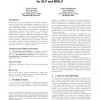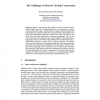89 search results - page 13 / 18 » Moore's Law is Unconstitutional |
GECCO
2007
Springer
14 years 1 months ago
2007
Springer
Engineering design increasingly uses computer simulation models coupled with optimization algorithms to find the best design that meets the customer constraints within a time con...
DAC
2006
ACM
14 years 1 months ago
2006
ACM
VLSI engineers have traditionally used a variety of CAD analysis tools (e.g. SPICE) to deal with variability. As we go into deep sub micron issues, the analysis is becoming harder...
DAC
2006
ACM
14 years 1 months ago
2006
ACM
Silicon technology based nonvolatile memories (NVM) have achieved widespread adoption for code and data storage applications. In the last 30 years, the traditional floating gate ...
APCSAC
2005
IEEE
14 years 1 months ago
2005
IEEE
Moore’s law describes the growth in on-chip transistor density, which doubles every 18 to 24 months and looks set to continue for at least a decade and possibly longer. This grow...
DATE
2005
IEEE
14 years 1 months ago
2005
IEEE
As Moore’s Law continues to fuel the ability to build ever increasingly complex system-on-chips (SoCs), achieving performance goals is rising as a critical challenge to completi...


